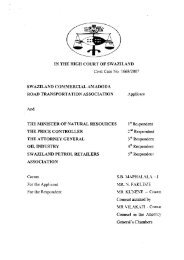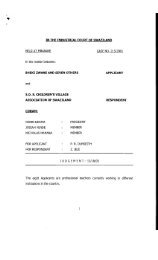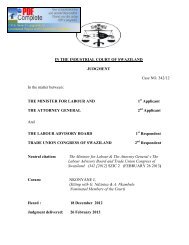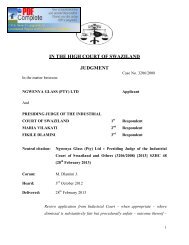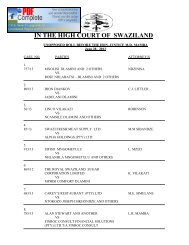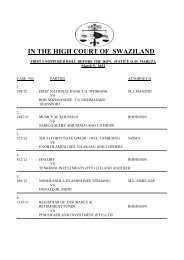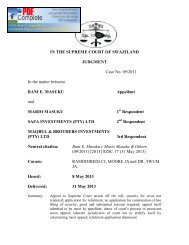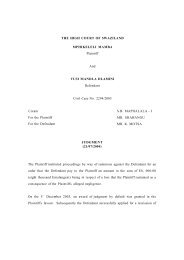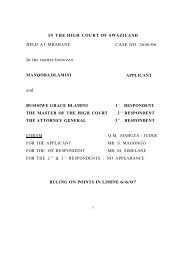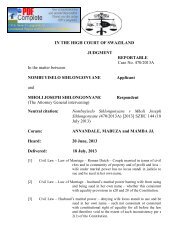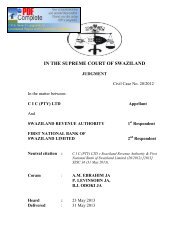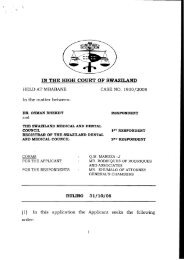Rex vs Musa Maziya and Another.pdf - SwaziLII
Rex vs Musa Maziya and Another.pdf - SwaziLII
Rex vs Musa Maziya and Another.pdf - SwaziLII
- No tags were found...
Create successful ePaper yourself
Turn your PDF publications into a flip-book with our unique Google optimized e-Paper software.
IN THE HIGH COURT OF SWAZILANDJUDGMENTCase No. 438/11In the matter betweenREX<strong>and</strong>MUSA MAZIYASIZWE DLAMININeutral Citation:<strong>Rex</strong> v <strong>Musa</strong> <strong>Maziya</strong> &<strong>Another</strong> (438/11) [2012] SZHC248 (23 October 2012)Coram:Mamba JHeard: 30/07/12, 01/08/12, 03, 04 <strong>and</strong> 08 October, 2012Delivered: 23 October 2012[1] Criminal Procedure – on a charge of rape – complainants shown to have lied on manymaterial aspects – their evidence rejected.[2] Criminal law <strong>and</strong> procedure – cautionary rule in respect of evidence of young children –corroboration only required where the evidence of such young children is credible <strong>and</strong>reliable. Where such evidence cannot be relied upon, no corroboration necessary orrequired.[3] Criminal law <strong>and</strong> procedure - on a charge of rape – where the accused is shown to haveallowed a ten year old girl to play with his penis – such is an immoral <strong>and</strong> indecent act.[4] Criminal law - on a charge of rape – a contravention of section 3 (1) of the Girls‟ <strong>and</strong>Women‟s Protection Act, is a competent verdict – where the evidence proves acommission of an immoral <strong>and</strong> indecent act.[5] Criminal Procedure – where indictment alleges the existence of aggravatingcircumstances as defined in section 185(bis) – the import <strong>and</strong> nature of these allegationsshould be explained by the court to an undefended accused.
2[1] Both Accused persons face an indictment that alleges that they are guilty ofthe crime of rape. The first Accused, <strong>Musa</strong> <strong>Maziya</strong> is alleged to have rapedNosimilo Matsenjwa, a ten year old girl whilst the second accused, SizweDlamini is alleged to have raped Tengetile Matsenjwa, who was also tenyears old at the time of the commission of the offence. These offences aresaid to have been committed on 28 th May 2011 at or near Mzilikazi area inthe Lubombo Region.[2] The indictment also alleges in each instant that the crime is accompanied byaggravating factors as defined under section 185 (bis) of the CriminalProcedure <strong>and</strong> Evidence Act 67 of 1938 (as amended) in that:„(i)(ii)The victim was a minor of a tender age.The accused did not use a condom thus exposing the victim to therisk of contracting sexually transmitted infections includingHIV/AIDS.(iii)(iv)(v)The accused raped the complainant repeatedly.The accused inflicted a life long trauma on the victim [<strong>and</strong>],The accused broke the victims virginity.‟[3] Immediately after the plea by the accused, I took the liberty to advise themthat the significance of the allegations by the crown that the crimes wereaccompanied by aggravating factors was that in the event they are found
3guilty of rape <strong>and</strong> the court holds that indeed there are aggravating featurespresent, the court shall be enjoined to pass a sentence of not less than 9(nine) years of imprisonment. I took this step because, procedurally I think,a court is enjoined to do so where the accused is not represented, otherwisesimply reading the indictment to him as it is without this explanation seemsmeaningless to me. In saying so though, I do not for a moment suggest thatwhere such information or explanation is not conveyed to the accused, thecourt is precluded from invoking the provisions of the relevant section ofthe law or that this lack of explanation amounts to an irregularity in theproceedings. The explanation merely makes the allegations of aggravatingfactors meaningful to the undefended accused <strong>and</strong> brings the seriousness orgravity of the charge closer home to him.[4] Although the second accused (A2) was acquitted <strong>and</strong> discharged at theclose of the crown case, this judgment also contains my reasons for thatdischarge.[5] Both Accused persons pleaded not guilty to the indictment <strong>and</strong> the crownled a total of nine witnesses in the quest to prove or establish its case. Iobserve from the outset that the evidence of the two complainants Pw2 <strong>and</strong>Pw3, is materially or substantially the same <strong>and</strong> both witnesses gave theirevidence through the aid of an intermediary, Ms Olivia Ndlangam<strong>and</strong>la, a
4social worker with about nine (9) years experience in the job. She was dulysworn in before she could undertake the task at h<strong>and</strong> after I had satisfiedmyself that she qualified to act as an intermediary.[6] The complainants have one father but have separate mothers. Their fatheris Isaac Themba Matsenjwa (Pw7).Thobile Dlamini, Pw6 is Pw2‟sbiological mother. The court was not told who the mother of Pw3 is. Bothchildren, however, lived together with their father <strong>and</strong> Pw6. Their homewas at a place known as eMatjeni in the Mzilikazi area near Siteki. It isapparently situated near the home of Brenda Sithole who runs or operates ashebeen from there. The accused were apparently, some of her regularcustomers or patrons of her liquor business.[7] According to Pw2 <strong>and</strong> Pw3, the complainants – in the evening of 28 th May,2011 they were playing with other children at the home of Brenda Sithole.These children included Celimpilo Dlamini, otherwise also known asSizumbulu. He gave evidence as Pw4. As the complainants left Sithole‟shomestead on their way to their home, they were called by the accusedpersons who indicated that they wanted to send them somewhere. Whenthey got to the accused, the first accused got hold of Pw2 by her arm <strong>and</strong>the second accused did the same to Pw3. The accused pulled the childreninto a nearby forest or bush <strong>and</strong> once in there, each of the accused ordered
5his victim to lie down on the ground <strong>and</strong> remove her panties. They werethen each raped by her captor whilst a knife was placed on her neck. Theywere told not to shout or cry out for help. They were threatened with deathshould they do so. Pw4 came <strong>and</strong> witnessed them both being raped <strong>and</strong>went away without having said or done anything. Later, the children heardtheir mother, calling out their names. Again their captors ordered them notto respond to her, lest they would be killed by them. By this time it wasdark in the forest.[8] Later, a police motor vehicle came by <strong>and</strong> shone its lights near Sithole‟splace, but then left the scene without sporting the accused <strong>and</strong> their victimsin the forest. The accused again held the complainants by their arms <strong>and</strong>pulled them to a homestead that was unknown to these witnesses. (It iscommon cause that this is the home of Vumelani Mamba who gaveevidence as Dw2). At this home, the accused were give a room by one ofthe persons found there. The accused laid or spread out grass mats on thefloor. Again, each accused caused his victim to lie thereon <strong>and</strong> they wereraped once more. After the rape, the complainants were caused to sleep onone grass mat whilst the two accused shared another one in the same room.[9] The next morning, the complainants were released by their captors <strong>and</strong> toldto go home. Pw2 went home whilst Pw3 went to her teacher‟s house.
6[10] On arrival home, Pw2 was received <strong>and</strong> interviewed by Pw5 (NtombikayiseMahlalela) who is a community social worker. Pw2 related to Pw5 whereshe had been over night <strong>and</strong> how she <strong>and</strong> Pw3 had been each raped by theaccused. The matter was then reported to the police <strong>and</strong> subsequently, thecomplainant was taken to the Good Shepherd hospital where she wasexamined by a medical practitioner, Dr Asha Varghese (Pw1).[11] Pw1 noted that Pw2‟s hymen was absent <strong>and</strong> that she was suffering fromgonorrhoea.She said Gonorrhoea is a sexually transmitted disease orinfection. She was unable to say what had happened to Pw2‟s hymen <strong>and</strong>when she had lost it.Again, she was unable to say when Pw2 hadcontracted the said infection.[12] In her evidence, Pw2 told the court that A1 had raped her twice before theincident of the 28 th May 2011 <strong>and</strong> on each occasion he had warned her notto reveal this to anyone or he would kill her. She had obeyed, out of fear,she said.[13] As stated above, the evidence of Pw3 is substantially similar to that of Pw2,in respect of how they were abducted <strong>and</strong> eventually raped by the accusedpersons. Pw3 stated that they were raped at two different spots in the forest
9I have no hesitation whatsoever in accepting his evidence <strong>and</strong> the veracitythereof. That, however, cannot be said about the complainants.[18] When the complainants were taken from near their home by the accused, itwas not yet dark. This occurred near Sithole‟s home where there were a lotof people. If indeed they were abducted or taken against their will, onewould have expected them to cry out for help.Again at VumelaniMamba‟s home where they spent the night with the accused, they did noticethe presence of some one there to whom a report could have been made ifthey had been brought there against their will. No report was made. Evenat night, no attempt by them was made to try <strong>and</strong> escape whilst their captorsslept. On being released by their captors, Pw3 never went home to reportthat she had been abducted by the accused. Instead she went to stay withher school teacher until she was collected from there by Celimpilo. Herexplanation or reason that she was afraid to go home because she spent thenight away from home without her parents‟ permission is, even for a girl ofher age, plainly unreasonable <strong>and</strong> unbelievable.Its only reasonableexplanation is that she had gone away from home willingly <strong>and</strong> was afraidto face the consequences of her indiscretions. If she had been taken awayagainst her will, I see no reason why she would be afraid to return home toexplain this to her parents. There is further no evidence that she reportedher supposed abduction to the said teacher.
10[19] The above criticism leveled against the evidence of Pw3 applies with equalmeasure to the testimony of Pw2.On her return home, she was afraid totalk to her mother. Infact when her mother approached her she retreated<strong>and</strong> was only able to relate her story of having been abducted by theaccused to Pw5 (Ntombikayise Mahlalela).But more importantly <strong>and</strong>fundamentally, the evidence of Pw4, Celimpilo establishes in my judgmentthat the complainants willingly went away with the accused persons <strong>and</strong>were willing participants with whatever took place between them <strong>and</strong> theaccused persons. The complainants have deliberately lied that they weretaken <strong>and</strong> kept away from home by the accused persons against their will.[20] Experience has taught the courts <strong>and</strong> taught them well, that young childrenare prone to suggestions <strong>and</strong> are impressionable. Because of this fact, thecourt has to view their testimony with caution <strong>and</strong> where they, as witnesses,are credible <strong>and</strong> trustworthy, the court has to find corroboration of theirtestimony before it can say that the crown has proven its case on the matterunder consideration. In Bhekithemba Kunene v <strong>Rex</strong> Criminal Appeal12/2009 this court had this to say:„Experience has taught us that she is, at that age, prone tosuggestion <strong>and</strong> imagination. Her imagination <strong>and</strong> that whichhas been suggested to her, easily becomes a fact in her youngmind.
11“…It has frequently been emphasised that [the evidence of young children]should be scrutinised with great care. The danger is not only that children arehighly imaginative but also that their story may be the product of suggestion byothers. In sexual cases, for example, a child who is prompted by leadingquestions when he or she first makes a complaint is quiet likely to believe thatthings which were suggested to him or her really happened.” (DT ZEFFERTet al, The South African Law of Evidence, 2003 at 806).‟Even where corroboration is required, it is in respect of credible evidence.Evidence that is not worthy of credence requires no corroboration. It st<strong>and</strong>sto be rejected.[21] In the present case <strong>and</strong> for the reasons stated above, I am unable to believethe evidence of the complainants herein.It would be extremely <strong>and</strong>dangerously unsafe to rely on their evidence. Because of this conclusion,there is absolutely no reason to go into the next stage in the inquiry; namelyto determine whether or not their evidence is corroborated by otherindependent <strong>and</strong> credible testimony.[22] But, just in case I am wrong in the analysis <strong>and</strong> evaluation of the evidenceof the complainants, there is no evidence that either of them had sexualintercourse at the relevant time. That both witnesses did not have theirhymen is no evidence that they had sexual intercourse at the relevant time.
12Pw3 was examined by a doctor on 30 th May 2011; the 2 nd day after thealleged sexual assault. If indeed she had lost her hymen then <strong>and</strong> also bledat the scene as a result of the alleged sexual intercourse, evidence of suchtearing of the hymen or injury to her organs of generation would have beenobserved or noted by the doctor who examined her, as such would havebeen fresh or been recent injuries. Some women of course are born withouta hymen.[23] I am not unmindful of the undisputed evidence by the doctor that Pw2 wasfound to have been afflicted with gonorrhoea which is a sexuallytransmitted infection. But again, that fact does not inexorably point to thefact that she had sexual intercourse at the relevant time <strong>and</strong> that such sexualintercourse was with the first accused herein.There is merit in theargument or suggestion by the first accused that if indeed he had had sexualintercourse with her at the material time, he would have contracted thesame infection too.There is no evidence that he suffered from suchinfection. (There is evidence that upon his arrest <strong>and</strong> being told that Pw2was infected with Gonorrhoea, he dem<strong>and</strong>ed that he be examined to provethat he had no such infection as he reasoned that if he also had such aninfection, that would go a long way to disprove his claim of innocence.
13[24] In R v Mario Masuku, Criminal case 348/2008, in considering section 174(4) of the Criminal Procedure <strong>and</strong> Evidence Act 67/1938, this court statedas follows„[3] Section 174(4) of the Criminal Procedure <strong>and</strong> Evidence Act 67of 1938 provides as follows:“If at the close of the case for the prosecution, the court considersthat there is no evidence that the accused committed the offencecharged or any other offence of which he might be convictedthereon, it may acquit <strong>and</strong> discharge him.”The meaning <strong>and</strong> import of these provisions were explained byMasuku J in the case of REX V OBERT SITHEMBISOCHIKANE AND ANOTHER, Crim 41/2000 (judgement deliveredon the 16 th July, 2002) as follows:“An analysis of the application of this Section in our jurisdiction wasundertaken by Dunn J in THE KING VS DUNCAN MAGAGULAAND 10 OTHERS, CRIM. CASE NO. 43/96 (unreported). He cameto the following conclusion at page 8 of the judgement:-„This section is similar in effect to section 174 of the South AfricanCriminal Procedure Act 51 of 1977. The test to be applied has beenstated as being whether, there is evidence on which a reasonableman acting carefully might convict.‟From the legislative nomenclature employed, it is clear that thedecision to refuse a discharge is a matter that lies within thediscretion of the trial Court. The use of the word “may” is indicativeof this. In the case of GEORGE LUKHELE AND 5 OTHERS VSREX C.A. CASE NO. 12/95 (unreported), it was held that no appeallies against the refusal of a trial Court to discharge an accused at theconclusion of the prosecution‟s case. It is however important to
14mention that this discretion must be exercised judicially <strong>and</strong> whetherin any case the application will be granted is dependant upon theparticular circumstances of the matter before Court.”‟I reiterate these remarks herein.Based on the above analysis <strong>and</strong> evaluation of the evidence by the crown, Iruled that there was no real evidence implicating the second accused herein,i.e. there is no evidence on which a reasonable man acting carefully mightconvict him. Consequently he was acquitted <strong>and</strong> discharged at the close ofthe crown case. But based on the evidence of Sizumbulu that he found thefirst accused lying on top of Pw2 <strong>and</strong> that he also witnessed Pw2 shaking orplaying with the exposed penis of the first accused, I held that there wasevidence implicating him. The first accused denied the allegations by Pw4on this issue in his evidence in his defence.[25] I have already analysed the quality of the evidence of Pw4 above <strong>and</strong> Ientirely accept it. I accept that he was no doubt an inquisitive person whospecifically went out to find out what was going on between the accused<strong>and</strong> the complainants. The presence of the accused in the company of thecomplainants at the relevant time is not in issue herein. Further, the firstaccused did not dispute or deny the presence of Sizumbulu in the forestwhilst he was with the complainants <strong>and</strong> his co-accused. He denied thesexual intercourse or alleged nature of his conduct or interaction with Pw2.
15His evidence in this regard cannot reasonably possibly be true insofar as itis contrary to that of Pw4. It is hereby rejected as a lie.[26] The next question in the inquiry or trial is what does the evidence by thecrown <strong>and</strong> in particular by Pw4 establish or prove? Plainly, it does notprove that the accused had sexual intercourse with Pw2. It establishesbeyond any reasonable doubt two things namely that:(a) the accused permitted himself <strong>and</strong> did expose his person or penis to Pw2<strong>and</strong> Pw2 enjoyed <strong>and</strong> played with it <strong>and</strong>,(b) at one stage or instance the accused laid on top of Pw2 whilst the zip ofhis trousers was unfastened.[27] There is no evidence as to what the first accused was doing as he laid ontop of Pw2 or in what position the two were in. It may be too tempting oreasy to assume or suspect that some form of sexual encounter was takingplace between them but such assumption or suspicion cannot, in law,ground a conviction for rape or any of the competent verdicts cognizable inour law. I say so fully recognizing that assault is a competent verdict on acharge of rape, <strong>and</strong>, to lie on top of someone may in an appropriate caseconstitute such offence. But, in the circumstances of this case, where Pw2was enjoying the company of the first accused, I cannot hold that the crownhas proven a case of assault beyond any reasonable doubt against him.
16Perhaps the maxim volenti non fit injuria applies here. (He who wills orwishes to be injured may not be injured or that to which a person consentscannot be considered an injury).[28] The first accused is 29 years old <strong>and</strong> must have been about 28 years old inMay last year when this offence was allegedly committed. He is married.On the other h<strong>and</strong>, Pw2 was ten years in May last year. So, the agedifference between them is 18 years. The two could not have been playmatesso to speak, but the accused allowed his person to be exposed toPw2.Infact he did not just expose it to her but rather allowed <strong>and</strong>permitted her to play with it. This court has been told Pw2 was laughing asshe did so, probably fascinated by what she saw <strong>and</strong> touched. The courthas not been told in what condition the accused penis was – whether erector not – but this is immaterial in my judgment. Something is immoral orindecent if it is depraved, dissolute, perverse or corrupts or has the potentialto corrupt one‟s morals. I am of the firm view that it is immoral <strong>and</strong>indecent for a 28 year old man to allow a ten year old girl to play with hispenis in the manner <strong>and</strong> under the circumstances described by Sizumbuluherein . It offends against the boni mores of a civilized <strong>and</strong> morally uprightsociety such as ours.
17[29] The facts in this case are distinguishable from those in <strong>Rex</strong> v NdumisoMasango, Review Case No. 25/2010, where this court stated as follows:„The mere proposal of love by a 26-year-old male to a 14-year-oldgirl is, to my mind, not on its own immoral or indecent. It may ofcourse be immoral or indecent if for example, the two personsinvolved fall or are within the prohibited bounds or degrees ofmarriage or, where the expression by which the proposal is made,the words or gestures used to convey it, are foul, ill tempered, illmannered or undisciplined. Nothing of the sort is conveyed by thecharge sheet in this case.‟This is not the case in the present matter.[30] Section 3(1) of the Girls‟ <strong>and</strong> Women‟s Protection Act 39 of 1920 providesas follows:„Every male person who has unlawful carnal connection with a girl under the ageof sixteen years or who commits with a girl under the age immoral or indecentacts or who solicits or entices a girl under such age to the commission of suchacts shall be guilty of an offence <strong>and</strong> liable on conviction to imprisonment notexceeding six years with or without whipping not exceeding twenty-four lashes<strong>and</strong> with or without a fine not exceeding one thous<strong>and</strong> emalangeni in addition tosuch imprisonment <strong>and</strong> lashes.‟And, section 185(1) of the Criminal Procedure <strong>and</strong> Evidence Act 67 of1938 provides that:„Any person charged with rape may be found guilty of assault with intent tocommit rape; or of indecent assault; or of assault with intent to do grievousbodily harm; or of assault; or of the statutory offence of unlawful carnal
18knowledge of, or committing any immoral or indecent acts with, a girl of orunder the specified age; or of the statutory offence of having or attempting tohave unlawful carnal connection with a female idiot or imbecile undercircumstances which do not amount to rape, or an attempt to commit rape, or ofcommitting or attempting to commit any immoral or indecent act with suchfemale, if such be the facts proved.‟[31] The only reported case I was able to get during my brief research on thetopic is R v DLAMINI, CECIL, 1987 – 1995 (1) SLR 146. The facts inthat case are of course distinguishable from the present case, as the accusedwas convicted of committing an immoral or indecent act on the basis thatthe evidence by the crown „fell short of establishing that the accused hadsucceeded in penetrating‟ the complainant.[32] A girl below the age of 12 years is irrebuttably presumed incapable ofconsenting to sexual intercourse or to an immoral or indecent act.Vide R v Ndw<strong>and</strong>we, Doctor, 1987 -1995 (3) SLR 201 (which isincidentally repeated at page 362 of the same report), where the accusedwas found guilty notwithst<strong>and</strong>ing that the girl had consented to the sexualintercourse.[33] For the foregoing reasons, the first accused is found guilty of committingan immoral <strong>and</strong> indecent act with a girl under the age of 16 years in
19Contravention of section 3(1) of the Girls‟ <strong>and</strong> Women‟s Protection Act 39of 1920.MAMBA JFor the Crown:For the Defence:Ms E. MatsebulaIn person



